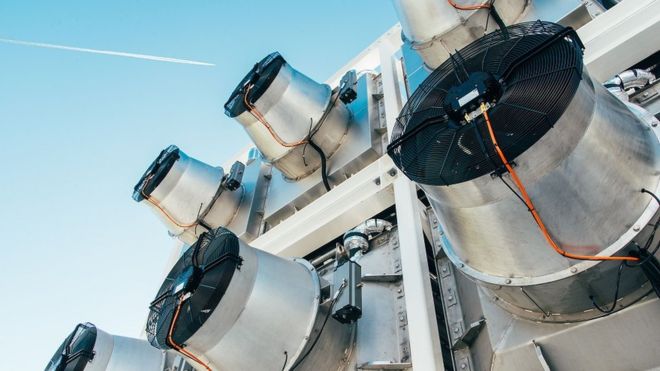
“This is the future of aviation,” Oskar Meijerink tells me in a café in Rotterdam airport.
His company, in partnership with the airport’s owners, is planning the world’s first commercial production of jet fuel made, in part, from carbon dioxide (CO2).
Based at the airport, it will work by capturing CO2, the gas which contributes to global warming, from the air.
In a separate process, electrolysis splits water into hydrogen and oxygen. The hydrogen is mixed with the captured CO2 to form syngas, which can be transformed into jet fuel.
The pilot plant, which aims to produce 1,000 litres of jet fuel a day, will get is energy from solar panels.
The partners in the project hope to produce the first fuel in 2021.
They argue that their jet fuel will have a much smaller CO2 impact then regular fuel.
“The beauty of direct air capture is that the CO2 is reused again, and again, and again,” says Louise Charles, from Climeworks, the company which provides the direct air capture technology.
Oskar admits that the fuel has a long way to go before it is competitive.
“The main element is the cost,” Oskar Meijerink concedes.
“Fossil jet fuel is relatively inexpensive. Capturing CO2 from the air is still a nascent technology and expensive.”
Other companies are working on similar direct capture systems, including Carbon Engineering in Canada and US-based Global Thermostat.
But environmental campaigners are highly sceptical.
“It sure does sound amazing. It sounds like a solution to all of our problems – except that it’s not,” said Jorien de Lege from Friends of the Earth.
“If you think about it, this demonstration plant can produce a thousand litres a day based on renewable energy. That’s about five minutes of flying in a Boeing 747.
“It’d be a mistake to think that we can keep flying the way that we do because we can fly on air. That’s never going to happen. It’s always going to be a niche.”
While companies are experimenting with high tech ways to capture CO2 from the air, there’s already a very simple, efficient way to do it – growing plants. And aircraft are already flying on renewable fuels made from plant biomass.
Sugar cane, grasses or palm oil, and even animal waste products – effectively anything that contains carbon – can be processed and used.
But are these alternative fuels are never going to replace traditional fossil jet fuel?
“Yes, but it’s very difficult to set a time frame,” says Joris Melkert, senior lecturer in aerospace engineering at Delft University of Technology.

